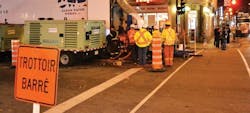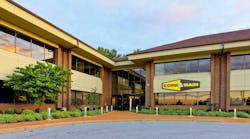Cured-in-Place Method Renews 73,000 ft of Pipe in Montreal
Clean Water Works Inc. (CWW) has completed the lining of approximately 73,000 ft of mainline sewer in Montreal’s East and West sectors using Inliner Technologies’ method of cured-in-place pipe. Work on the two projects, valued at a combined $22.7 million, began in May 2012 and was completed within 11 months.
Like many large North American cities, Montreal’s sewers first took root in the late 1800s, with the bulk of the infrastructure built in the decades following the Great Depression. With an average age of more than 50 years, a comprehensive pipe rehabilitation program was critical to maintaining the city’s sewer infrastructure.
The East Sector project encompassed 38,057 ft of pipe under a contract for $11.6 million, and the West Sector project encompassed 35,104 ft of pipe with a value of $11.1 million. Approximately 70% of the pipe renewed by CWW was 24-in.-by-36-in. egg-shaped brick sewer, with the remaining 30% consisting of concrete round pipe ranging from 12 to 72 in. in diameter.
The combined sewer pipes were located under arterial streets through major intersections in downtown Montreal, an area that is home to many hotels, bars and restaurants. To minimize disturbances to these businesses, much of the lining was performed at night.
“There was a tremendous amount of coordination with the community to ensure that disruptions were kept to a minimum,” said Nicolas Brennan, project manager for CWW. “We met with all the local businesses to make sure we properly understood their needs, and prepared case-specific bypass solutions—which, in some cases, included using large submersible pumps and pumper trucks to transfer the effluent downstream or into vacuum tankers to be hauled to CWW’s treatment plant.”
CWW also prepared extensive traffic control plans, subject to city approval, and obtained separate road occupation permits from a dozen city boroughs.
Internal coordination was carefully orchestrated as well, with two crews installing an average of two liners per day. The tubes were wet out at CWW’s facility in Ottawa, Ontario, Canada, at night, then transported to the jobsite to begin the installation process in the morning. A night crew would reinstate the service connections; then the process would start all over again the next day.
“When you add in the liner transport, diversion pumping, pipe cleaning, traffic control and host of other details that need to take place, you really need to have your schedule nailed down and be communicating well across the board,” said Sandy Campbell, rehabilitation manager for CWW. “Once the project planning for each liner had been established and each member of the crew was made aware of the specific details, the hard part of the project was completed and we were just left to do what we do best—install liners in the ground.”
Approximately 100 concrete spot repairs were required from the interior to fill voids prior to lining. The majority of these repairs were completed manually by confined-space man-entry crews.
The contract also included lining approximately 300 catch basin leads (for a total length of approximately 6,000 ft) connected to the mainline sewers. In cases where the leads could not be rehabilitated due to defects such as major offset joints, sumps or breaks, the drains were excavated and replaced. The catch basin work was subcontracted to local contractors Dassyloi and Brivac.
Despite the enormous complexity, these comprehensive lining projects finished on time and on budget. CWW credits the Inliner network as an important tool for the company’s success. “The ongoing collaboration within the Inliner network and focus on new processes and tools is critical to keeping us at the forefront of the industry,” Brennan said.
Download: Here


